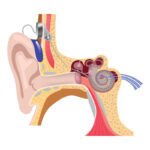Causes and Solutions for Pulsatile Tinnitus in One Ear
Pulsatile tinnitus is one ear that can be caused by several different conditions. Here are some causes and solutions for pulsatile tinnitus in one ear. If your pulsatile tinnitus is accompanied by ringing in the ear, you should see a doctor right away. If you suspect it may be related to an underlying medical condition, your doctor may refer you to an ophthalmologist or a vascular specialist to rule out possible vein or eye problems.
Sigmoid sinus diverticulum
Sigmoid sinus diverticulum is a rare etiology of pulsatile tinnituses of one ear. It is a blood-carrying channel on the side of the brain that exits via the internal jugular vein. During the process of a person's life, it may become infected or enlarged. This condition is diagnosed by the physician's examination, and if there is a diagnosis, surgery may be necessary.
A 31-year-old woman had a three-year history of pulsatile tinnitus in her right ear. She had a low-pitched audible bruit around the right mastoid, and her hearing was reduced or increased with compressing the right upper neck and left the jugular region. Her otoscopic examination was normal. She was given an intravenous contrast injection to enhance the images. A conventional cerebral angiogram revealed a small sigmoid sinus diverticulum (7×6 mm).
While there is little evidence to support a causal relationship between Sigmoid sinus diverticula and PT, it may contribute to elevated intracranial pressure in patients with PT. In addition, Sigmoid sinus diverticula are associated with venous stenosis, which has been hypothesized to play a role in sound generation. In some cases, treatment for the diverticulum and venous PT should be done concurrently.
Sigmoid sinus dehiscence is also a potential cause of pulsatile tinnituses in one ear. The dehiscence is most common in SSWA patients and may be a complication of idiopathic intracranial hypertension. It may also be associated with an undiagnosed SSWA.
Glomus tumors

In cases of pulsatile tinnituses in one ear, it is possible that a mass in the glomus tympanicum is causing the problem. Such a tumor usually involves erythema and occupies the middle ear cavity. The mass may also invade nearby structures and secrete vasoactive and catecholamine substances. Although a glomus tumor causes pulsatile tinnitus in only one ear, it can sometimes transform into a malignant tumor. The site of origin is determined by the cellular composition of the tumor.
Diagnostic imaging is critical in the diagnosis of glomus tumors. They are typically reddish-purple vascular masses that resemble normal paraganglia. A glomus tumor has characteristic clusters of chief cells (called zellballen, literal translation of cell balls) that are enhanced by silver staining. Although this pattern may not be appreciated in smaller tumors, it is important to consider this tumor in the context of other causes of pulsatile tinnitus in one ear.
Another cause of pulsatile tinnituses in one ear is a tumor of the glomus jugulare. Although rare, this type of tumor can be mistaken for a dural fistula, and a doctor should rule out a dural fistula. As a result, it is important to seek medical treatment as soon as possible.
Surgical resection is the mainstay for the treatment of glomus tumors. This condition is the most common cause of pulsatile tinnitus in one ear, and surgical resection is the primary method of treatment. As with other causes of pulsatile tinnitus, treatment involves the removal of the tumor or a combination of surgical approaches.
Sigmoid sinus dehiscence

Surgical repair of the sigmoid sinus wall has been found to be effective for patients with pulsatile tinnituses in one ear. The procedure involves localizing the dehiscence through the mastoid bone and covering the affected area with bone or a bone substitute. The tinnitus generally resolves after the resurfacing. However, sigmoid sinus dehiscence may occur in patients with other causes of pulsatile tinnitus.
The underlying cause of pulsatile tinnituses is still unclear. While it is widely considered the most common tinnitus condition, there is still considerable controversy over its exact cause. In general, sigmoid sinus dehiscence is a rare cause of PT. A high resolution CT scan is needed to make a definitive diagnosis.
Studies conducted on the vascular wall of the sigmoid sinus revealed that the displacement was significantly below the audible frequency range. However, current in vitro and computational studies do not provide the same results as in vivo displacement sensing. Furthermore, the vascular wall of the sigmoid sinus is firmly fixed to the concave surface of the sigmoid plate, which is connected by the dura mater. In addition, the tissues overlying the sigmoid plate may influence the movement of the vascular wall. Therefore, it is possible that the vascular wall can be underestimated, causing an overestimation of the dehiscent area.
This treatment is effective in some cases. In some cases, Botox injections can be effective, but this is a temporary solution. Botox injections can cause temporary palatal insufficiency, which limits the use of these treatments. Some patients may experience periauricular numbness, the collapse of the retroauricular area, and acoustic impedance. However, despite these limitations, the surgery does not appear to be a permanent solution for pulsatile tinnitus in one ear.
Sigmoid sinus stenoses
Sigmoid sinus stenoses are a cause of pulsatile tinnitus in one ear. The sigmoid sinus is located at the base of the skull and may be narrowed, which can lead to changes in blood flow and pressure. Patients with pulsatile tinnitus should see a doctor if they believe that they have venous sinus stenosis. If these symptoms occur only in one ear, there may be a problem with the transverse sinus. In the event of a venous sinus stenoses, treatment should involve a high resolution CT scan.
A middle-aged female presented with left pulsatile tinnitus for a week and then developed right ear tinnitus. The noise became more prominent during physical activity and in quieter environments. Neurologic, otologic, and ophthalmologic evaluations were normal. Noninvasive imaging, including a lumbar puncture and CT of the brain with bone window, showed dehiscence of the sigmoid plate and stenosis at the transverse artery and sigmoid sinus junction.
Surgical treatment for sigmoid sinus stenoses should be a last resort. Surgery is not required, but a conservative approach is recommended in the case of pulsatile tinnitus in one ear. The surgeon may perform a sigmoid sinus resection with a small graft in order to reduce occlusion pressure.
Patients with sigmoid sinus stenosis may benefit from venous stenting to restore blood flow. Venous stenting is an excellent treatment option for venous stenoses and has been described as a safe, effective alternative to surgery for pulsatile tinnitus. Further studies are needed to determine whether the procedure is safe and effective for PT in patients with sigmoid sinus stenosis.
Sigmoid sinus strictures
Symptoms of sigmoid sinus strictures in pulsatile tinnitus in one ear only were atypically rare in a middle-aged woman. She presented with a persistent noise in her right ear that improved upon physical exertion and worsened with left-sided neck compression. Neurologic, otologic, and ophthalmologic evaluations were normal. Sigmoid sinus strictures were diagnosed based on noninvasive imaging, including a CT of the brain with a bone window and an MR venogram.
Surgical intervention is required if the symptoms are severe enough to require a surgical procedure. In some patients, a sigmoid sinus diverticulum or dehiscence is a possible cause. The surgical procedure involves the reconstruction of the sigmoid sinus wall. If the surgery is successful, the patient's pulsatile tinnitus will resolve.
Despite the complexity of pulsatile tinnitus disorders, surgical intervention may be required. Using magnetic resonance imaging (MRI) to determine the full velocity field in 3D space throughout the cardiac cycle is an ideal way to study venous sinus strictures in one ear. This diagnostic technique allows doctors to assess the flow patterns of blood in the sigmoid sinus, a major vein in the head.
Sources:
- Mayo Clinic. Pulsatile Tinnitus. https://www.mayoclinic.org/diseases-conditions/tinnitus/symptoms-causes/syc-20350156
- National Institute on Deafness and Other Communication Disorders. Tinnitus. https://www.nidcd.nih.gov/health/tinnitus
- Gao, L., Zhang, J., & Zeng, R. (2021). Diagnosis and surgical treatment of sigmoid sinus stenosis causing pulsatile tinnitus: A case report. Medicine, 100(28), e26592. https://doi.org/10.1097/MD.0000000000026592
- Qureshi, M. M., Sun, H., Wenig, B. L., & Deeb, R. H. (2010). Glomus Tumors of the Head and Neck. The Annals of Otology, Rhinology, and Laryngology, 119(11), 795–799. https://doi.org/10.1177/000348941011901104







